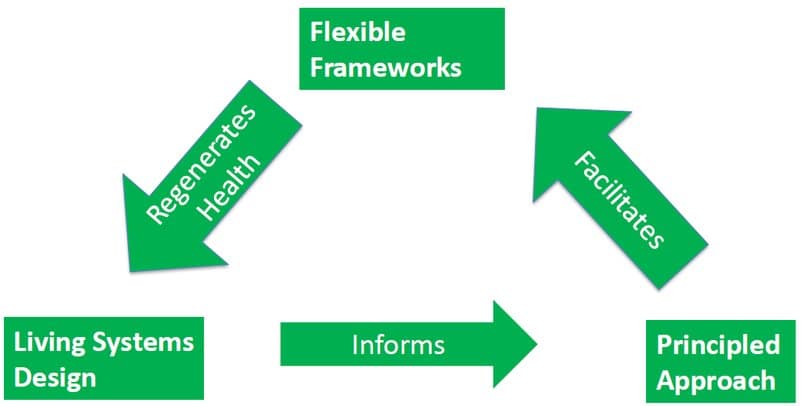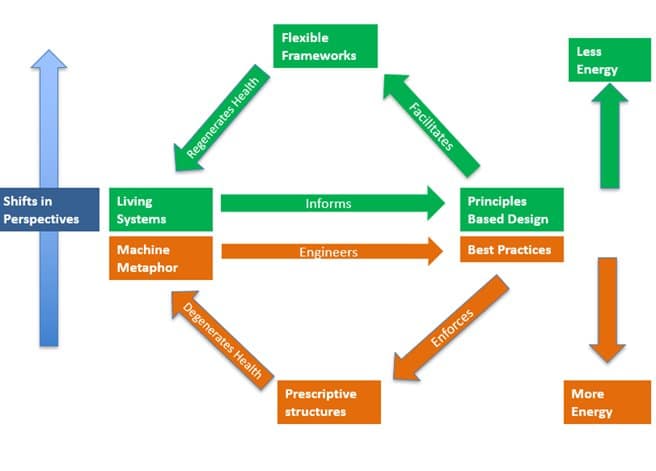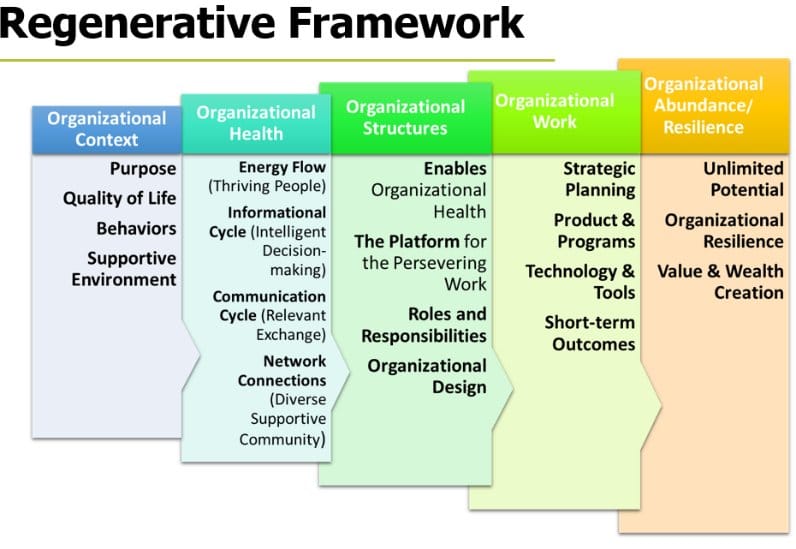This is the third in the series of Regenerative Unravelled. You can read the previous posts here:
Part one – An introduction to the principles of being Regenerative
Part two – Regenerative as a Living System
We have previously explained that the current paradigm is mechanistic where people, farms and businesses are treated as machines or parts of a machine and managed to produce at all costs. It is all about output and not the health of the system or its parts. This has huge unintended consequences which show up as some of society’s most challenging issues including climate change, environmental degradation, societal and community breakdown and the increase in toxic and nutritionally related health issues.
Living systems are complex systems and require a holistic systems approach. Maturana and Varela, from the ‘Santiago School’ in Chile, through their ground breaking work explained
the defining aspect of life is the ability to self-maintain and self-regenerate!
This led to the defining characteristics of life and living systems as:
- Self-Regenerative ability is not located in any one place, it is nodal or decentralised
- Life is dependent on the interconnected relationships of all parts of the cell
- Life is a holistic (emergent) property of all “parts” of the cell and relationships between the parts
- Each “part” is also a self-regenerative (autopoetic) system so the cell as one whole is made up of other wholes within it, each able to regenerate themselves.
They also showed that the cell creates its own wall or boundary and it is only within this boundary that the complex inter-connections function to support self-maintenance and regeneration.
It is this inter-connectedness that sustains life in living systems and creates the conditions for regeneration. Death or lack of life (degeneration) is the loss of the ability to self-regenerate. More specifically death involves the breakdown of the interconnected relationships within the cell wall or boundary. As in cells, the break down of these inter-connections within organisations, communities and farms leads to degeneration and death.
Understanding life and living provides the 6 principles which characterise a regenerative system.
- Holism. Interrelated and dependent.
- Mutualism. Inherent value and dependence in the other.
- Uniqueness. Original and the possibility of individual genius.
- Evolutionary. Maintains a dynamic balance with ever-changing environmental conditions.
- Nodal. Decentralized and distributed.
- Developmental. Growth and health of the members.
And a working characterisation of regenerative as;
A living, evolving and naturally functioning environment where abundance and resilience are recurring outcomes of its underlying health
So, this becomes a design issue. By understanding the root cause and the principles which will create the conditions to heal, we can change the design.
When we use a mechanistic design on complex problems we get frustration and unintended consequences. Machines are created to deliver strictly predetermined outcomes from the application of prescribed practices. These practices do not need complex interconnections between members or parts and limit the potential output of the machine only to that for which it was designed.
The principles of the living system are not catered for, the health of the system degenerates and becomes increasingly dependent on external inputs to maintain productivity.
Application of a complicated machine design to a living system
Moving from a mechanistic paradigm to a living systems paradigm requires shifts in behaviour:
- From best practices to principles
- Allowing principles to guide evaluation & design. Solutions are context specific
- From prescriptions to responsive frameworks
- Creating structures that are flexible, adaptable and responsive for the changing environment
- From dominance to interdependence
- Within and between organizations
- Competition to cooperation
- From prediction to pattern
- Creating conditions for health and emergence
- From extraction to equity
- People are the energy source of organisations
- Focusing on the development of the whole versus the few
- From centralised power to decentralised empowerment
- Intelligent and resourced decision making through the organisation
Applying these shifts within the principles of living systems creates a different outcome; the ability to self-maintain and regenerate.
When these two design concepts are considered together the benefits of the living systems design become obvious. More external energy/inputs are required to maintain the mechanistic design as any inherent energy in the system is degenerated.
A classic example of this is in soil. If the soil becomes dirt it no longer has the ability to support the farming operation without constantly increasing inputs or fertiliser, pesticides and herbicides. The connections required to sustain the soil food web break down and this impacts the health of the whole system right through to the depreciating quality of the food we eat and the associated impacts on our health.
A similar example is people within an organisation. They provide the energy of the organisation. If the organisation is not structured to support the health of the people it degenerates and dies.
To facilitate this planning process we use a Regenerative Design Framework create by our partner, nRhythm.
This Framework serves as;
- A Design Framework as a way to design with principles in mind.
- A Process Framework to reflect the flow within the organisation.
- A Decision-making Framework so decisions can be made with the whole in mind and for the health of the whole, not just the problem, issue or outcome which is top of mind and may not be in the bests interests of the whole.
The emphasis is to first set the conditions for health which then inform the entire decision-making process and generation of outcomes. The organisational context defines the boundary within which the entity is to operate or the whole, the expectations of the members of the whole and who they behave to each other.
These behaviours enable or disable organisational health.
The elements of organisational design (or ecosystem processes in the case of land) put health at the core and create the conditions for potential to show up. The health of these elements can be monitored to indicate the health of the system. The structures created to support organisational health are designed first to enable the health of the system and then as a platform for the collective work.
Designing without such a framework with focus only on the planning, tools and outcomes becomes a mechanistic design process and does not consider the principles of a living system. When we just focus on the strategic plan we are really just reorganising work, not creating conditions for something new to emerge with the ability to release more potential than realised.
By applying these principles to the design of our systems, be that ourselves and families, farms, businesses, organisations, communities, and government, we create the conditions within those entities which deliver health, abundance and resilience to all parts/members and potential beyond what can be predicted.
Ata Regenerative are at the forefront of regenerative agriculture practice in New Zealand. With 17 years working in the regenerative space and as the only EOV provider in the country, Ata Regenerative can assist with your transition to farm practice that focuses on the regeneration of soils, increased productivity and biological diversity, as well as economic and social well-being. To find out more, contact us here.









